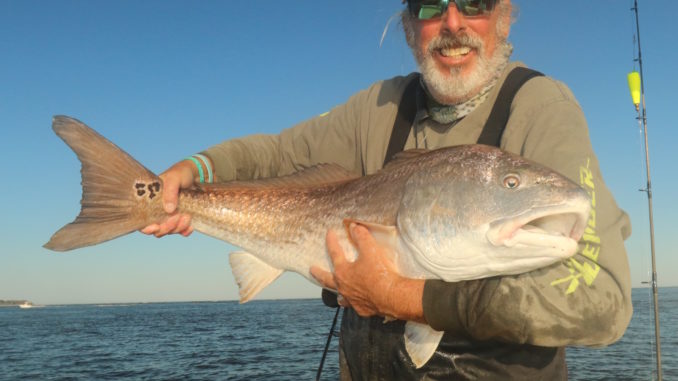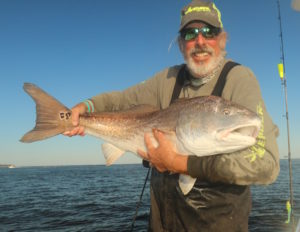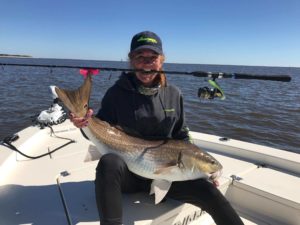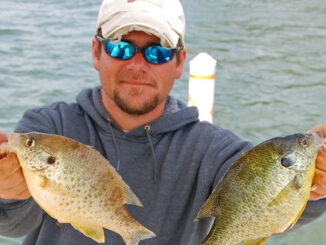
Lure, cork combo makes bull redfishing more fun
This time of year, anglers up and down the coast of both Carolinas can find trophy redfish much closer to shore than any other time of the year. These big bulls, which can range in size from 35 to over 50 pounds, come inshore to spawn, then head back out to the bluewater until next fall.
The most popular way of catching these big fish is to use live or cut bait on a Carolina rig. It’s a tried-and-true method that is as simple as it is effective. But for anglers looking for a more fun — and more hands-on way of catching them — Capt. Rod Thomas of Capt. Ponytail Guide Service has just the ticket.
For years, Thomas (336-240-5649) has used a popping cork/artificial lure combo in North Carolina’s Pamlico Sound with a lot of success. But this year, he’s been using this combo in other places along the Carolina’s coastlines too. And no matter where he uses it, his angling clients tell him they’d rather catch one on this rig than 10 redfish on the bottom with natural bait.

“It’s the type of fishing that guys who want to be more involved will love. When fishing with a Carolina rig, you can just put the rod in the rod holder and let the fish find the bait and hook themselves. With the popping cork/artificial lure combo, the angler is constantly working to entice one of these fish into biting. It’s a lot more hands-on, and a lot of anglers like that,” said Thomas, who has spent the last few weeks catching bull redfish in Winyah Bay outside of Georgetown, South Carolina.
“I started doing this in Pamlico Sound years ago, and it works so well up there that I don’t even take natural bait as a backup when I have clients. This method is just that reliable there. The water there is usually clearer, so I can see the fish and actually tell my clients where to cast, when to pop the cork, and when to get ready for a strike,” he said.
Thomas fishes from an Avenger 26-foot bay boat with a tower, and from the tower, he can see much more than he can from the deck of the boat. With a depth finder, steering console, throttle control, and remote control for his electric motor all on the tower, he can control every function of the boat while also getting a better view. Having that raised view, especially when the water is clear, gives him the ability to help his clients in ways he couldn’t without the tower.
“But even in Winyah Bay, where the water is usually not very clear, this method is working. You’re casting blind more often here than in Pamlico Sound so the percentage of bites is lower, but we’re still catching fish this way. It’s a numbers game. The more casts you make, the more fish you’ll catch. It is a really fun way to catch them, and it’s just not something very many people try in Winyah Bay yet, but the ones who do really love it,” he said.
Thomas said the key is using a concave popping cork, which makes a louder popping sound than the more streamlined corks. And he suggests anglers pop them in a violent fashion, making as loud a sound as possible.

“When you pop the cork, the lure comes up almost all the way to the surface, then when you pause, the lure sinks. The redfish usually hit it while it’s dropping. You want to pause long enough that the lure can fall almost all the way down the length of your leader, then pop it really hard again. If you’re fishing too fast, you’ll get fewer bites,” he said.
Stout rods with 6000 series spinning reels, line in the 60 to 80 pound class, large popping corks, and 5-inch swimbaits make up Thomas’ terminal tackle when fishing this way.
Thomas makes his living fishing at the hottest spots in the Carolinas. He fishes from North Carolina’s Roanoke River down to South Carolina’s Winyah Bay, and at several spots in between. He fishes where the fishing is hot, and he has many repeat customers who have caught their largest ever fish, then caught an even bigger one with him on their next trip. Click here for more information on fishing with Capt. Ponytail.




